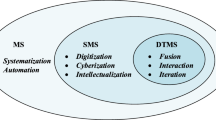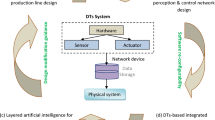Abstract
If the classic fatal development approach's conventional distribution procedure reveals structural flaws, digital twin (DT) can enable hardware-in-the-loop modeling of individual actual devices and cyber models that may be exploited to prevent the significant expense of production method transformation. A quad-play CMCO (configuration, motion, control, and optimization) concept structure is proposed for the development of the flow-type smart manufacturing system in the Industry 4.0 environment, which is dependent on the DT concept. The CMCO architecture system repetition mechanism is explained. The comprehensive embedding of the quad-play CMCO paradigm and the DT approach are two significant design approaches for permitting the customizable and development tools construction of flow category smart manufacturing systems. Depending on the CMCO concept, a version of the DT (digital twin) system-developed proposed methods are demonstrated. A literature review of the glass industrial sector is used to support the validity of the development cost that relies on DTs. The outcome demonstrates the viability and efficacy of the DT system-based design scheme.











Similar content being viewed by others
References
Leng J, Ruan G, Jiang P, Xu K, Liu Q, Zhou X, Liu C. Blockchain-empowered sustainable manufacturing and product lifecycle management in industry 4.0: a survey. Renew Sustain Energy Rev. 2020;132:110112.
Leng J, Wang D, Shen W, Li X, Liu Q, Chen X. DTs-based smart manufacturing system design in Industry 4.0: a review. J Manuf Syst. 2021;60:119–37.
Leng J, Ye S, Zhou M, Zhao JL, Liu Q, Guo W, Fu L. Blockchain-secured smart manufacturing in industry 4.0: a survey. IEEE Trans Syst Man Cybern Syst. 2020;51(1):237–52.
Morgan J, Halton M, Qiao Y, Breslin JG. Industry 4.0 smart reconfigurable manufacturing machines. J Manuf Syst. 2021;59:481–506.
Chen G, Yao D, Zhou Q, Li H, Lu R. Distributed event-triggered formation control of USVs with prescribed performance. J Syst Sci Complex. 2022;35(3):820–38.
Choi SH, Park KB, Roh DH, Lee JY, Mohammed M, Ghasemi Y, Jeong H. An integrated mixed reality system for safety-aware human–robot collaboration using deep learning and DT generation. Robot Comput-Integr Manuf. 2022;73: 102258.
Leng J, Zhou M, Xiao Y, Zhang H, Liu Q, Shen W, Li L. DTs-based remote semi-physical commissioning of flow-type smart manufacturing systems. J Clean Prod. 2021;306:127278.
Latchoumi TP, Swathi R, Vidyasri P, Balamurugan K (2022, March) Develop new algorithm to improve safety of WMSN in health disease monitoring. In: 2022 international mobile and embedded technology conference (MECON). IEEE, pp 357–362
Ma H, Ren H, Zhou Q, Lu R, Li H. Approximation-based nussbaum gain adaptive control of nonlinear systems with periodic disturbances. IEEE Trans Syst Man Cybern Syst. 2021;52(4):2591–600.
Tao F, Xiao B, Qi Q, Cheng J, Ji P. DT modeling. J Manuf Syst. 2022;64:372–89.
Bu L, Zhang Y, Liu H, Yuan X, Guo J, Han S. An IIoT-driven and AI-enabled framework for smart manufacturing system based on three-terminal collaborative platform. Adv Eng Inform. 2021;50: 101370.
Sneha P, Balamurugan K (2023) Investigation on wear characteristics of a PLA-14% bronze composite filament. In: Recent trends in product design and intelligent manufacturing systems. Springer, Singapore, pp 453–461
Zhang Y, Zhang C, Yan J, Yang C, Liu Z. Rapid construction method of equipment model for discrete manufacturing DT workshop system. Robot Comput-Integr Manuf. 2022;75: 102309.
Maheshwari P, Kamble S, Belhadi A, Mani V, Pundir A. DT implementation for performance improvement in process industries—a case study of food processing company. Int J Prod Res. 2022. https://doi.org/10.1080/00207543.2022.2104181.
Wu L, Leng J, Ju B. DTs-based smart design and control of ultra-precision machining: a review. Symmetry. 2021;13(9):1717.
Ante L, Fischer C, Strehle E. A bibliometric review of research on digital identity: research streams, influential works and future research paths. J Manuf Syst. 2022;62:523–38.
Garikapati P, Balamurugan K, Latchoumi TP, Malkapuram R. A cluster-profile comparative study on machining AlSi 7/63% of SiC hybrid composite using agglomerative hierarchical clustering and K-means. SILICON. 2021;13:961–72.
Zhang F, Bai J, Yang D, Wang Q. DT data-driven proactive job-shop scheduling strategy towards asymmetric manufacturing execution decision. Sci Rep. 2022;12(1):1–19.
Anwer N, Ballu A, Mathieu L. The skin model, a comprehensive geometric model for engineering design. CIRP Ann. 2013;62(1):143–6.
Wang J, Niu X, Gao RX, Huang Z, Xue R. DT-driven virtual commissioning of machine tool. Robot Comput-Integr Manuf. 2023;81: 102499.
Li H, Li B, Liu G, Wen X, Wang H, Wang X, Yang W. A detection and configuration method for welding completeness in the automotive body-in-white panel based on DT. Sci Rep. 2022;12(1):1–11.
Manocha A, Afaq Y, Bhatia M. DT-assisted blockchain-inspired irregular event analysis for eldercare. Knowl-Based Syst. 2022;260:110138.
Jiang J, Li H, Mao Z, Liu F, Zhang J, Jiang Z, Li H. A DT auxiliary approach based on adaptive sparse attention network for diesel engine fault diagnosis. Sci Rep. 2022;12(1):1–18.
Salem T, Dragomir M. Options for and challenges of employing DTs in construction management. Appl Sci. 2022;12(6):2928.
Latchoumi TP, Ezhilarasi TP, Balamurugan K. Bio-inspired weighed quantum particle swarm optimization and smooth support vector machine ensembles for identification of abnormalities in medical data. SN Appl Sci. 2019;1:1137. https://doi.org/10.1007/s42452-019-1179-8.
Anand M, Balaji N, Bharathiraja N, Antonidoss A. A controlled framework for reliable multicast routing protocol in mobile ad hoc network. Mater Today Proc. 2021. https://doi.org/10.1016/j.matpr.2020.10.902.
Zhao R, Zou G, Su Q, Zou S, Deng W, Yu A, Zhang H. DTs-based production line design and simulation optimization of large-scale mobile phone assembly workshop. Machines. 2022;10(5):367.
Zheng Z, Liao W, Lin J, Zhou Y, Zhang C, Lu X. DT-based investigation of a building collapse accident. Adv Civ Eng. 2022;2022:9568967.
Cheng K, Wang Q, Yang D, Dai Q, Wang M. Digital-twins-driven semi-physical simulation for testing and evaluation of industrial software in a smart manufacturing system. Machines. 2022;10(5):388.
Funding
The authors declare that no funding has been received to carry out the work.
Author information
Authors and Affiliations
Corresponding author
Ethics declarations
Conflict of Interest
The authors declare that they have no conflict of interest.
Additional information
Publisher's Note
Springer Nature remains neutral with regard to jurisdictional claims in published maps and institutional affiliations.
This article is part of the topical collection “Research Trends in Computational Intelligence” guest edited by Anshul Verma, Pradeepika Verma, Vivek Kumar Singh and S. Karthikeyan.
Rights and permissions
Springer Nature or its licensor (e.g. a society or other partner) holds exclusive rights to this article under a publishing agreement with the author(s) or other rightsholder(s); author self-archiving of the accepted manuscript version of this article is solely governed by the terms of such publishing agreement and applicable law.
About this article
Cite this article
Ramesh, P.S., Vanteru, M.K., Rajinikanth, E. et al. Design and Optimization of Feedback Controllers for Motion Control in the Manufacturing System for Digital Twin. SN COMPUT. SCI. 4, 782 (2023). https://doi.org/10.1007/s42979-023-02228-8
Received:
Accepted:
Published:
DOI: https://doi.org/10.1007/s42979-023-02228-8




